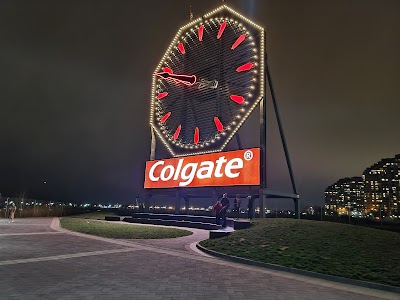Colgate Clock (Colgate Clock)
Overview
The Colgate Clock in Santiago del Estero, Argentina, is a captivating landmark that beautifully intertwines historical significance, engineering marvel, and cultural heritage. Nestled in one of Argentina's oldest cities, this iconic timepiece draws the attention of both locals and tourists eager to uncover the rich tapestry of history and unique charm of the area.
Originally installed in 1930 by the Colgate-Palmolive Company, a prominent American multinational, the clock was part of a larger marketing strategy aimed at solidifying the brand's presence in Argentina. However, it served as more than just a promotional tool; it was a gift to a city celebrated for its diverse cultural heritage. Over time, the clock emerged as a beloved symbol of Santiago del Estero, admired for both its impressive scale and the technical ingenuity behind its construction.
One of the clock's most striking features is its size. Towering high with a face diameter measuring several meters across, it ranks among the largest clocks in South America. The sheer scale, coupled with the intricate details of its design, captures the attention of passersby from all directions. Its classic clock face, adorned with bold Roman numerals and ornate hands, recalls the grand traditions of historic clock-making.
Beyond its engineering prowess, the Colgate Clock stands as a symbol of time in a city steeped in history. Founded in the mid-16th century, Santiago del Estero is recognized as Argentina's oldest city, having witnessed pivotal historical events and transformations over the centuries. The clock serves as a poignant reminder of the city's resilience and the timeless richness of its cultural legacy.
Over the years, the Colgate Clock has become an integral part of the Santiago del Estero skyline. Its central location makes it easily accessible to tourists, providing an ideal backdrop for photographs and a popular meeting point for city tours. Visitors are often enchanted by the clock's night display, where it lights up beautifully against the backdrop of the city's historic architecture.
For foreign tourists, a visit to the Colgate Clock offers a unique opportunity to immerse themselves in the local culture, architecture, and history. Local guides and historians frequently use the clock as a starting point to share the story of Santiago del Estero, taking visitors on a journey through colonial times, the influence of European settlers, and the city’s transformation into the modern era.
An intriguing aspect of the Colgate Clock is its meticulous maintenance. Despite being over ninety years old, the clock remains well-preserved and continues to function accurately. This dedication reflects the city's commitment to safeguarding its historical landmarks and highlights the clock’s importance to the community. Regular upkeep ensures the timepiece remains operational, consistently chiming the passing hours for the city's residents.
The clock's installation during a period of modernization in Santiago del Estero also underscores the impact of globalization and industrial advancements on the city. The choice of this locale by an American company to install such a prominent landmark signifies the international connections and influences that have shaped the region over the years.
Moreover, the Colgate Clock serves as an educational tool, particularly for young visitors and students. Schools often organize field trips to the clock, where children not only learn about the mechanics of timekeeping but also delve into the history and significance of this monument. In this way, the clock plays a vital role in educating future generations about their heritage and the importance of preserving historical sites.
In conclusion, the Colgate Clock in Santiago del Estero is much more than just a timekeeping device. It embodies a rich history, an engineering marvel, and a cultural symbol all in one. For foreign tourists, it provides an enriching experience, allowing for deep engagement with the local culture and history. Standing tall, the clock is a silent witness to the passage of time, serving as a bridge between the city’s storied past and its vibrant present.







